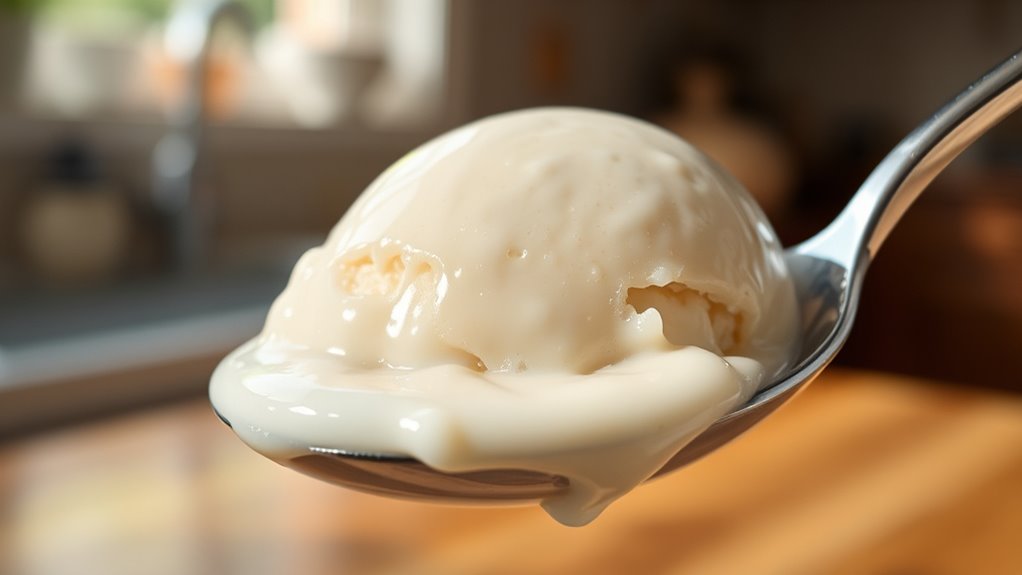To soften ice cream quickly without turning it into soup, try placing it in the fridge for 10-15 minutes to gently soften or use a cold water bath by sealing it in a plastic bag and submerging it for 5-10 minutes. You can also microwave in short bursts at low power, checking frequently. These methods keep the texture and flavor intact while softening the ice cream efficiently—discover more tips for perfect results here.
Key Takeaways
- Use the refrigerator method by placing ice cream in the fridge for 10-15 minutes for gentle, controlled softening.
- Employ short bursts in the microwave on low power (20-30%) with frequent checks to prevent over-melting.
- Submerge sealed ice cream in cold water for 5-10 minutes, massaging gently for even softening.
- Avoid extended heat exposure and over-microwaving to maintain flavor, texture, and safety.
- Handle carefully and serve immediately after softening to preserve quality and scoopability.

If you need to soften ice cream quickly, there are simple methods that work faster than waiting for it to melt naturally. The key is to avoid rushing the process in a way that compromises safety or ruins the flavor. One of the most effective techniques involves using your refrigerator’s fridge or freezer environment wisely. For example, placing the ice cream container in the refrigerator for about 10-15 minutes can gently soften it without risking over-melting. This method maintains safety precautions because it keeps the ice cream at a safe temperature, preventing bacterial growth that can occur if it’s left out too long. Also, it helps preserve the flavor and texture, ensuring your ice cream tastes just as good as when you first bought it. Additionally, understanding the proper exfoliation techniques with glycolic acid can help maintain overall skin health, much like gentle handling preserves the integrity of your ice cream.
If you’re in a real hurry, you can try using the microwave with caution. Remove the ice cream from its carton and put it in a microwave-safe bowl. Use the defrost setting or set the microwave to a low power level—around 20-30%. Microwave it in short bursts of 10-15 seconds, checking after each interval. This prevents uneven melting or turning your ice cream into soup. Be vigilant to avoid overheating, which can affect flavor and texture, making it watery or grainy. Remember, safety precautions are critical here; never microwave ice cream long enough to melt completely, as it can splatter and create a mess, or worse, damage your microwave. Also, rapid heating can alter the flavor, so this method is best for quick softening rather than complete thawing.
Another effective way is to place the ice cream in a sealed plastic bag before submerging it in a bowl of cold water. Make sure the bag is tightly sealed to prevent water from seeping in. Submerge it for about 5-10 minutes, gently massaging the bag occasionally to encourage even softening. This method is safe, quick, and helps preserve the flavor since the ice cream stays at a controlled, cool temperature. It’s essential to monitor the process, so you don’t accidentally over-soften or create a watery consistency. Keep in mind that these techniques work best if you plan to serve the ice cream immediately afterwards, as prolonged softening can compromise texture and flavor.
In all cases, always handle ice cream with care, paying attention to safety precautions, and avoid exposing it to heat for too long. These methods will help you achieve the perfect softness without sacrificing flavor, and they’re simple enough to do in a pinch. By understanding the right techniques and timing, you get soft, scoopable ice cream fast—without turning it into a runny mess or risking safety issues.
Frequently Asked Questions
Can Softening Ice Cream Affect Its Flavor?
Softening ice cream can impact its flavor if you’re not careful. Rapid softening might cause ingredient interaction, leading to flavor loss or changes. To preserve flavor, you should soften it gradually at room temperature or in the fridge. Quick softening methods risk altering the delicate balance of ingredients, which can diminish the ice cream’s intended taste. Proper softening methods help maintain flavor preservation and keep your ice cream tasting just as delicious.
Is It Safe to Microwave Ice Cream Briefly?
Sure, microwaving ice cream briefly seems tempting, but is it safe? You might think it’s fine for microwave safety, yet uneven heating can make your ice cream’s consistency weirdly lumpy or melty. While a quick zap can soften it fast, you risk turning it into a liquid mess. So, if you want smooth, safe softness, use gentle methods instead of rushing with the microwave.
How Does Room Temperature Impact Ice Cream Softening?
You’ll find that room temperature critically impacts ice cream softening. As the temperature rises, the ice cream melts faster, so proper temperature control is essential. To preserve its texture while softening, use preservation techniques like letting it sit at room temperature for a few minutes, but avoid warm environments. This way, you soften it quickly without turning it into soup, maintaining its ideal consistency for serving.
Can Softening Methods Alter Ice Cream Texture?
Yes, softening techniques can change ice cream consistency. When you use methods like microwaving or leaving it at room temperature, you soften the ice cream, making it creamier and easier to scoop. However, too much heat can cause it to become melty or icy, altering its texture negatively. So, while softening methods improve scoopability, they also impact the overall ice cream consistency, so use them carefully.
What Is the Best Way to Re-Freeze Softened Ice Cream?
Think of your softened ice cream like a delicate sculpture—you want to reshape it without breaking it. To re-freeze, transfer the ice cream to an airtight container, smoothing the top. Use proper ice cream storage techniques and keep it at a consistent freezing temperature. This prevents ice crystals from forming, maintaining quality. Remember, quick refreezing with proper methods preserves its texture, so your treat stays creamy and delicious.
Conclusion
Now that you know the best way to soften ice cream quickly, you can enjoy it just the way you like without waiting. Imagine you’re hosting a last-minute get-together, and someone wants a scoop of frozen delight. By using a quick method like placing the tub in a warm water bath, you can serve creamy, perfectly softened ice cream in minutes. No more waiting—just smooth, delicious ice cream whenever you crave it!










